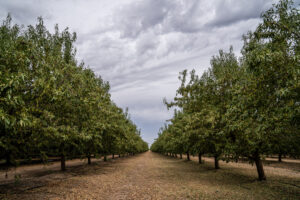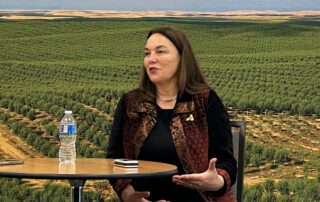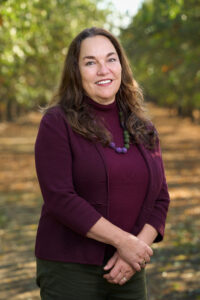USDA Projects Larger 2024 Almond Crop; Down 7 Percent from May Forecast
Courtesy of the Almond Board of California
Harvest 2024 predicted at 2.8 billion pounds while carryout expected to drop significantly.
The 2024 California Almond Objective Measurement Report published Wednesday by the U.S. Department of Agriculture’s National Agricultural Statistics Service (USDA-NASS) estimates that the crop harvested in 2024 will come in at 2.80 billion meat pounds.
The estimate is down 7 percent from USDA-NASS’s Subjective Forecast in May. It follows a generally solid bloom as well as a year in which growers faced a range of economic challenges. It also comes when the carryout is projected to drop to levels not seen in years as almond shipments set a record of 10 months straight of at least 212 million pounds shipped.
“The Objective Measurement is in line with what the industry expected and a drop from the Subjective Estimate. It reflects both a good bloom and hard work by California almond growers during trying times,” said Clarice Turner, president and CEO of the Almond Board of California. “For perspective, demand has been strong, consistent and continues to grow, which has reduced the carryout to what may be the smallest in years. California almonds shipped at least 212 million pounds each of the first 10 months of this crop year and averaged 230 million pounds a month. Never before has the industry shipped even 200 million pounds 10 months in a row in the same crop year.”
Turner said the Almond Board expects the almond supply to be similar to what was available in the past 2023-24 crop year.
“The actual supply of California almonds available for the market is the combination of crop size and carryout from the previous year,” she said, “We expect only minor changes, if any, to the supply for market this next crop year because the forecasted increase in crop size will mostly be offset by the smaller carryout. Clearly, global demand is strong and consistent. We will continue to work hard to meet growing demand.”
The 2023 harvest yielded 2.47 billion pounds, 5% below the 2023 Objective Report estimate, reflecting the difficulty of precisely forecasting crop size given the current fluctuations in weather and economic factors.
USDA-NASS said the 2024 harvest is expected to be on schedule. “The 2024 almond crop experienced mostly favorable weather during the bloom period,” the report said. “Bee hours were reported to be significantly higher than last year. Wet and warm weather in April increased pest and disease pressure, but dry conditions and mild temperatures in May helped the developing crop. Multiple heat waves across the state during June and July required growers to increase irrigation on their orchards.”
USDA-NASS’ forecasted yield is 2030 pounds per acre, up from 1,790 in 2023. The forecast for the average nut set per tree is 4,072 up from 3,953 in 2023, while the average kernel weight for all varieties sampled was 1.61 grams, down from the 1.67 grams in 2023. The Nonpareil average nut set of 4,137 is up from 4,004 last year, and the average Nonpareil kernel weight was 1.64, down from 1.69 grams last year.
The 2024 Objective Report is based on actual almond counts using a statistically rigorous methodology. The survey was conducted from May 25 to June 28 and 1,904 trees were sampled in 952 orchards, the most ever, USDA NASS said. It was 40 more orchards than in 2023. USDA-NASS conducts the annual Objective Report, Subjective Forecast and Nursery Survey to provide the California almond industry with the data needed to make informed business decisions.



















